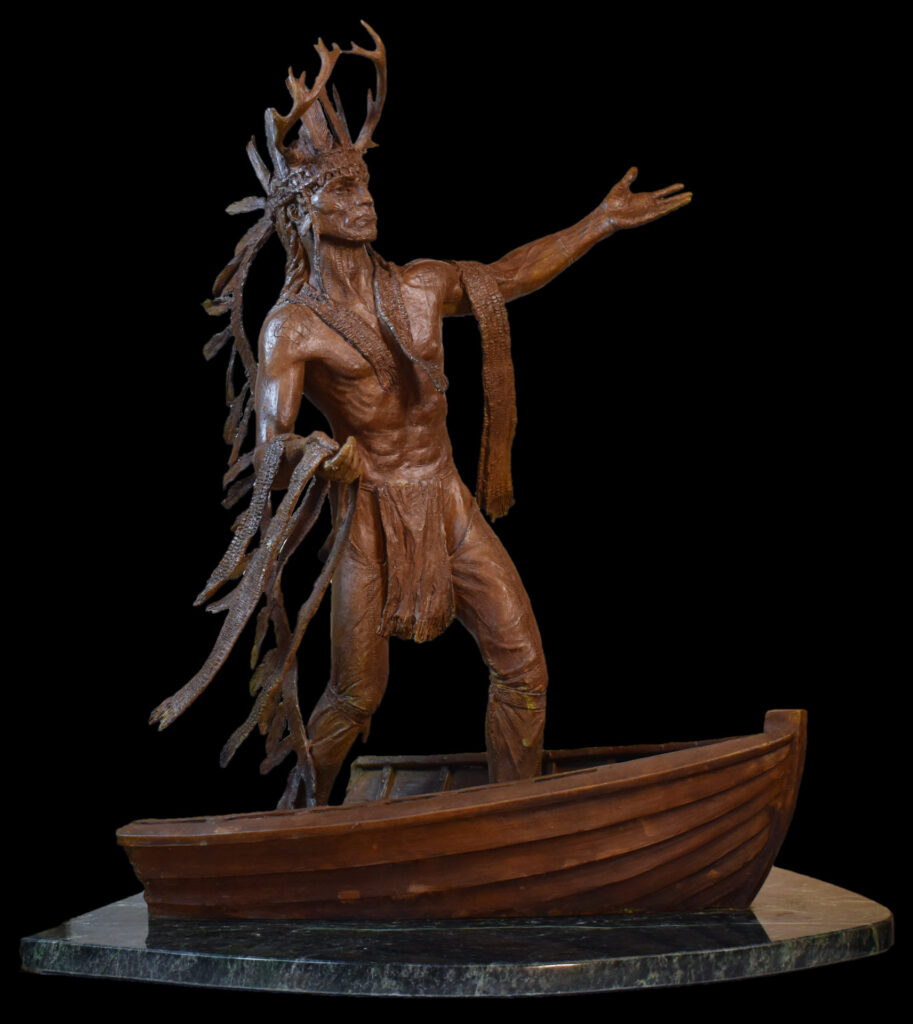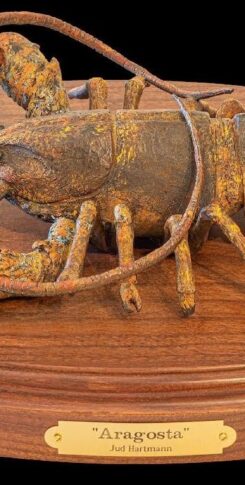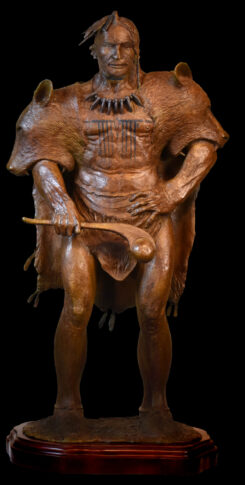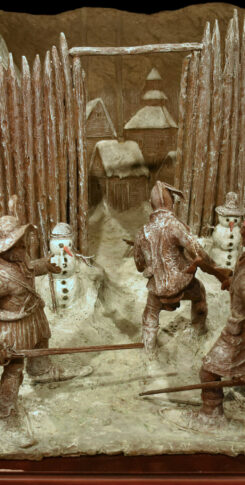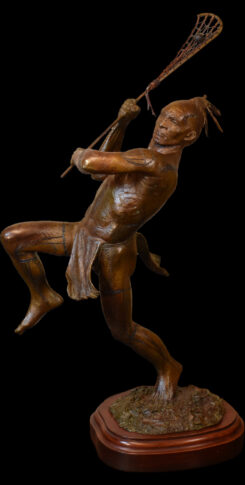Bronze edition: 20 | Height: 23″
“On the 5th of July, 1645, the Iroquois reappeared at Trois Riviere (Quebec) bringing with them two men of renown, ambassadors of the Mohawk nation. The chief of the Iroquois was Kiotsaeton of impressive size and symmetry. Standing erect in the prow of the French sailboat that had brought him and his companions from the Richelieu, he was covered from head to foot in belts of wampum and announced in a commanding voice that he was the accredited envoy of all his nation. Among those on shore, his appearance was cause for great celebration, and from the fort cannons were fired as a sign of rejoicing. Impressive as Kiotsaeton was physically, he was equally gifted intellectually and from his replies, the French soon conceived that they had to do with a man of esprit”
Fr. Vimont (1645)
“He undoubtedly belonged to that class of professed orators who had great influence among the Iroquois and were employed in all affairs of embassy and negotiation. They had memories trained to an astonishing tenacity, were perfect in all the conventional metaphors in which their diplomacy and rhetoric so much depended, knew by heart the traditions of the nation and were adept in the parliamentary usages which, among the Iroquois, were held little less than sacred.”
Francis Parkman (1867)
“There is no evil in my heart. My song is a song of peace.”
“The ambassadors were feasted for a week then the Grand Peace Council began. Along with the French and the Iroquois delegation were also representatives of the Huron and various Algonquin and Montagnais bands. “When all was ready Kiotsaeton arose, strode into the open space and raising his tall figure erect, stood looking for a moment at the sun. Then he gazed around on the assembly, took a wampum belt in his hand and began:
“‘Onontio*, give ear. I am the mouth of all my nation. When you listen to me, you listen to all the Iroquois. There is no evil in my heart. My song is a song of peace. We have many war-songs in my country; but we have cast them all away, and now we sing of nothing but gladness and rejoicing.’ With this he gave the first wampum belt to confirm his words … the fourth belt was an assurance that the memory of the slain no longer stirred the living to vengence. ‘I passed near the place where our warriors had been slain in the spring … I passed quickly; I would not look on the blood of my people. Their bodies lie there still; I turned away my eyes, that I might not be angry,’ then stooping, he struck the ground and seemed to listen. ‘I heard the voices of my ancestors crying to me in a tone of affection, “my grandson, my grandson, you cannot deliver us from death; think of the living, rescue them from the knife and the fire.” When I heard these voices, I went on my way and journeyed here’ …the 5th, 6th and 7th belts were to open the passage by water and the 8th cleared the path by land. You would have said, (writes Vimont), that he was cutting down trees, hacking off branches, dragging away bushes and filling in holes – so natural, that no actor in all France could equal it. ‘Look!‘ exclaimed the orator when he had finished his pantomime, ‘the road is open, smooth and straight;’ and he bent towards the earth as if to see that no impediment remained. ‘There is no thorn or stone or log in the way. Now you may see the smoke of our villages, from Quebec to the heart of our country…’ Then the speaker closed: ‘I go to spend what remains of the summer in my own country, in games and dances and rejoicing for the blessings of peace.'”
Fr. Vimont (1645)
“There was peace in this dark and blood-stained wilderness. The lynx, the panther and the wolf had made a covenant of love; but who should be their surety? Mingled with joy there was a doubt and a fear.”
Francis Parkman (1867)
* literally, “Great Mountain”; Iroquois term for all French governors of Canada derived from the 2nd Governor General of New France, Montmagny

